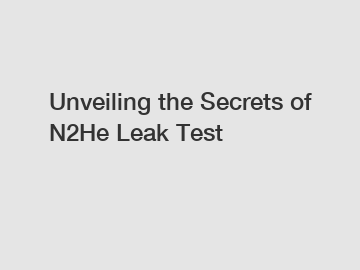Unveiling the Secrets of N2He Leak Test
Unveiling the Secrets of N2He Leak Test: How Does it Work?
What is the N2He leak test? How can it detect and locate leaks? Why is it a widely used method in various industries? In this article, we will explore the answers to these questions and delve into the intricacies of the N2He leak test. So, let's unveil the secrets of this fascinating method!
The N2He leak test, also known as the Nitrogen-Helium leak test, is a technique used to identify and pinpoint leaks in a sealed system. It involves the use of a mixture of Nitrogen (N2) and Helium (He) gases, which are excellent tracer gases due to their low molecular weight and low levels found naturally in the atmosphere.

2. How Does it Work?
The N2He leak test works on the principle of detecting the presence of helium gas outside the sealed system. Here's an overview of the process:
a. Pressurization: The sealed system is pressurized with a mixture of Nitrogen and Helium gases. The system is typically pressurized to a lower pressure than its working pressure, ensuring the safety and integrity of the components.
b. Leak Detection: If there is a leak present, the helium gas, being a small molecule, can infiltrate through even the tiniest openings or cracks in the system. Specialized detection equipment, such as mass spectrometers or helium leak detectors, is used to analyze the surrounding environment for the presence of helium gas.
c. Location of Leak: By precisely measuring the concentration of helium gas in the vicinity, the source of the leak can be located. The equipment used can pinpoint the exact location of the leak, enabling prompt repairs or replacements.
3. Applications in Various Industries:
The N2He leak test finds wide applications across different industries for its effectiveness and accuracy in leak detection. Here are some notable applications:
a. Automotive Industry: In automotive manufacturing, the N2He leak test is commonly used to ensure the integrity of various systems, including fuel tanks, cooling systems, and air conditioning units. Detecting and fixing leaks in these systems is crucial to guarantee optimal performance and safety.
b. Aerospace and Aviation: The stringent standards and safety regulations in the aerospace and aviation sectors demand rigorous leak testing. The N2He leak test is extensively employed to check the integrity of critical components, fuel systems, and pressurized cabins, reducing the risk of catastrophic failures.
c. Medical Equipment: Medical devices and equipment, such as oxygen concentrators, anesthesia machines, and vacuum systems, require high levels of reliability. The N2He leak test assures that no leaks compromise the functionality and safety of these life-saving devices.
4. Advantages and Limitations:
Like any method, the N2He leak test comes with its own set of advantages and limitations:
a. Advantages:
i. Sensitivity: The N2He test method offers high sensitivity to detect even the smallest leaks, ensuring the effective maintenance of system integrity.
ii. Accuracy: The ability to precisely locate leaks allows for targeted repairs and minimizes downtime during troubleshooting.
iii. Versatility: The test can be applied to different components, systems, and materials, accommodating a wide range of industry-specific requirements.
b. Limitations:
i. Cost: The specialized equipment and trained personnel required for N2He leak testing can add to the overall cost of the manufacturing or maintenance process.
ii. Time-Consuming: The N2He leak test may take longer to perform compared to other leak detection methods, potentially causing delays in production or maintenance schedules.
5. Conclusion:
The N2He leak test is an invaluable tool in ensuring the integrity and safety of sealed systems across various industries. With its ability to accurately detect and locate leaks, it plays a crucial role in maintaining the optimal performance and reliability of critical components. Understanding the secrets of the N2He leak test allows us to appreciate its significance and make informed decisions when it comes to leak detection and maintenance processes.
For more information, please visit Sub-sea Pipeline Testing, China Pipeline Process Services Provider, Electric Heat Tracing Design.

Comments
0